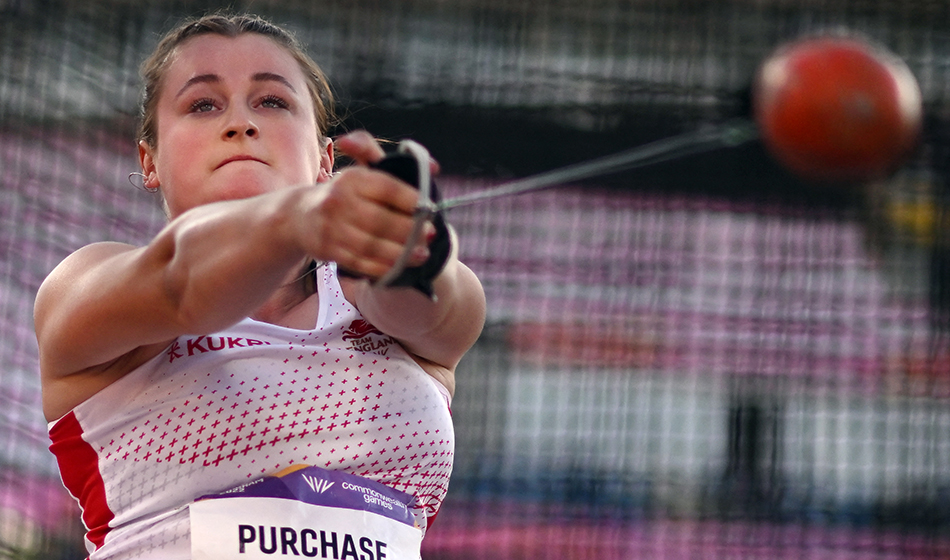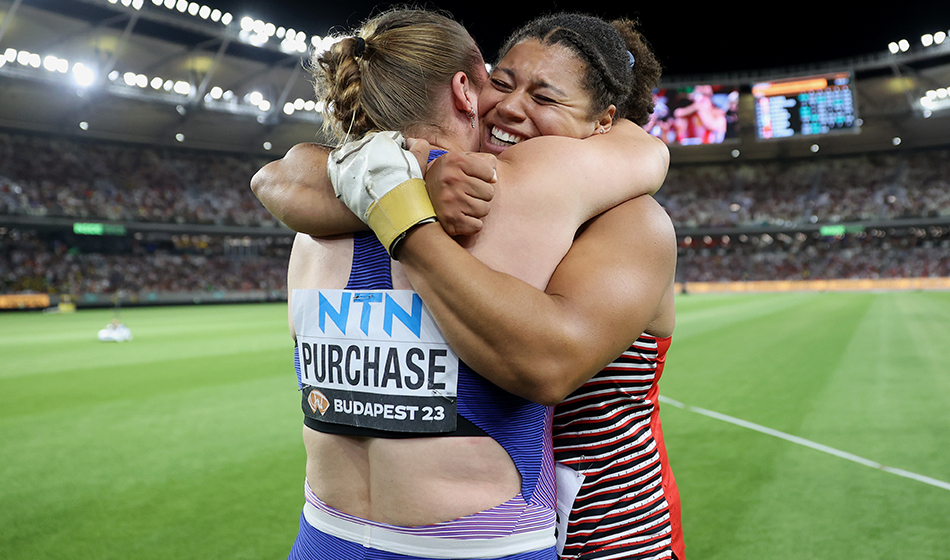Insights from the British hammer champion who has been able to use the heartache of missing out on Olympic selection to her benefit
Clichés are often overused, conveniently retrofitted for purpose. At the end of the day. It is what it is. Time will tell. But, sometimes, everything really does happen for a reason.
British hammer champion Anna Purchase moved from the UK to the USA as a teenager, first to study at the University of Nebraska-Lincoln, then later transferring to the University of California, Berkeley to be coached by Mo Saatara.
“I like to believe there’s some sort of energy out there in the universe that points you in the right direction,” says the 25-year-old who failed to respond to an initial approach from Saatara and UC Berkeley straight from high school (“I was naïve of the process and the coaching levels,” she says), only to get there eventually via a more unconventional route.
In her first year with Saatara, Purchase finished fourth at the European Under-23 Championships in 2021. In her second year she competed at the Commonwealth Games and senior European Championships and improved her personal best by four metres (to 70.63m at the time, the second British woman to exceed the 70m mark).
She graduated in 2023 with a bachelor’s degree in media studies and a master’s degree in the cultural studies of sports in education, but soon felt the weight of the world on her shoulders.
“The ‘first year out’ is exactly as tough as they say it is,” she says. “I was trying to figure out how to financially support myself, and although I knew I was capable of qualifying [for the Paris Olympics], the pressure of getting the ‘B’ standard plagued me throughout that entire year.”
Purchase had thrown a personal best of 73.02m – inside the 72.36m Olympic ‘B’ standard but outside of the qualifying period – at the Brutus Hamilton Invitational & Multis in April 2023 and backed that up with a 71.47m at the NCAA Championships (division one) in June.
She finished runner-up at the UK Athletics Championships in July and went on to make the final of the World Athletics Championships in Budapest in August, having qualified with her fourth-best throw ever (71.31m); but she struggled to adapt to life post-college as she balanced a minimum wage job with training to make her first Olympics.
Purchase went on to win the 2024 UK title, but her season’s best of 71.79m fell short of the required mark and she didn’t make it to Paris. At the time she was ranked 16th on the ‘Road to Paris’ rankings – meriting an invitation from World Athletics to compete – but without the British Athletics’ ‘B’ standard that fact was rendered meaningless.
“We put our lives, careers, and financial security on hold to pursue this sport, only to have the opportunity taken away because we are deemed ‘not good enough’ to make top eight or win a medal in our event,” she wrote on Instagram at the time. “If we are dismissed despite being among the best in the world, why would we continue?”
Life has a way of working itself out and from utter heartache, eventually, came hope. “It really helped me get perspective of what I wanted to do,” she reflects. “I realised I needed some balance and if I was going to do this for another Olympic cycle I needed to feel stable and happy and to know that I was progressing in other areas of my life.”

Saatara had thought she was going to quit – ‘I don’t know if I’d have been able to come back from that’, he’d told her – but non-selection had the opposite effect. Purchase bought a car which gave her more freedom to explore, she got a new job that gave her financial stability, and moved into her own apartment.
Throughout it all she had the support of an incredible training group “in a really fun environment” that includes Olympic hammer champion Camryn Rogers and discus world record-holder and Olympic silver medallist Mykolas Alekna amongst others.
Saatara is held in very high regard by those who know him. A UC Berkeley news article states that his coaching philosophy – focusing on how athletes tap into their individual strengths, rather than forcing them to fit into a mould of what a great athlete looks like – allows his throwers to reach heights of success that may have previously felt out of reach. To Purchase he’s a great coach, “but he’s a mentor and friend, too.”
Purchase is a worrier and is transparent about her struggles with anxiety and depression. She recalls how Saatara helped her alter her mindset after a moment of panic at the World Athletics Championships in 2023: “I was so nervous and he was like: ‘But how cool is this? We don’t get to do this very often, this is really cool’, so now I try to enjoy it all, especially the big meets. They’re really fun.”
There are, of course, more big meets on the horizon. Saatara is excited about Purchase’s prospects at this year’s World Athletics Championships in Tokyo – but hitting the ‘A’ standard of 74.00m is the priority before she can allow herself to dream.
“I’ve worked so, so, hard to get to where I am right now,” she says. “As much as it was awful not to go to the Olympics at the time, it forced me to reassess what I needed. I’m throwing so much better now because I’m happy and life is so much more stable.”
The next Olympic cycle is well underway and Purchase is in a good place. Los Angeles 2028 for this California girl? Maybe it’s written in the stars.

A typical training week
Purchase works full-time hours in a remote sales role for a legal technology start-up. She trains four days per week (Monday, Tuesday, Thursday and Friday).
Monday: (am) work; (pm) throwing session – general warm-up plus specific drill, for example wind turns, then throwing exercises with two to three different weight hammers (around 20-40 throws per session depending on time of year), followed by special exercises such as medicine ball work, plate twists and/or sprint drills, followed by early evening gym session, for example an Olympic lift session paired with another main exercise such as cleans with box squat, followed by a special exercise circuit and a light accessory circuit. “Our gym work is focused on lifting fast for explosiveness,” explains Purchase. “You don’t want to keep lifting heavier and heavier, you want to move better. I find the medicine ball work really helpful for that. It’s tiring as hell but you get that power.”
Tuesday: (am) work; (pm) throwing session followed by early evening gym session, such as cleans and box squats
Wednesday: work/rest. “I typically try to get out of the house and go for a walk on these days,” says Purchase.
Thursday: (am) work; (pm) throwing session followed by early evening gym session (as Monday)
Friday: (am) work; (pm) throwing session followed by early evening gym session (as Tuesday)
Saturday: rest
Sunday: rest
Favourite session: “I enjoy throwing a 5kg weight and a block with a 5kg/3kg pairing. When you throw the lighter weight it’s helpful because the 4kg moves a lot faster and further than you’re used to, so being able to get your throw together in training with a light ball is helpful when you get to a meet.”
Least favourite session: “Thursday’s lift session because I’m always so tired.”










